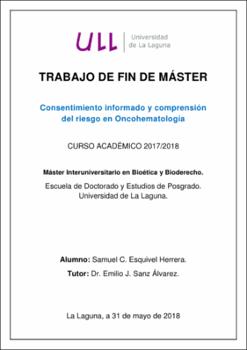Consentimiento informado y comprensión del riesgo en oncohematología.
Date
2018Abstract
A common error, even among experts,117 is identifying informed consent (IC)
with the specific document that the patient must sign (conditio sine qua non) so that
certain diagnostic or therapeutic techniques can be practiced, so the IC is limited to the
formal-legal practice of signing the acceptance "contract".48 For its part, the IC
document has colonized the medical consultations and is presented and signed almost
automatically by legal imperative.56 It is not strange that, in a paradoxical way, the
necessary IC procedure, what is achieved in many cases, is a signed but uninformed
document.118 Risk communication is an essential component in the decision-making
process shared with the patient. Providing information in a structured way, using a
language without technicalities, listening to the patient and attending to their values,
facilitates that the risks perceived by the patient adjust to the information actually
transmitted.63 In view of this situation, it is proposed to study whether the patients of the
Oncohematology Service of the University Hospital Complex of Ntra Sra de Candelaria
(CHUNSC), in Tenerife, which are going to be subjected to a treatment with
chemotherapy, after signing the informed consent they adequately understand the risks
secondary to the treatment and if they manifest concerns about it, trying to identify in
such a case if the causes can be the technical medical language and a little adequate
patient medical communication.
For the study a sampling of maximum variation was used that included 9 adult
patients of different cultural levels, ages and sex, with different degrees of
oncohematological diseases and users of the CHUNSC, specifically of the
Oncohematology Service, who had signed the informed consent to initiate
chemotherapy treatments. A phenomenological, exploratory-type qualitative study was
carried out in which it was not intended to quantify the intensity of any variable, but to
elicit the most relevant aspects for patients on the subjects of the study. For this
purpose, a semi-structured open interview was carried out, recorded and later
transcribed for its best analysis, being the participation in the study voluntary and the
data treatment anonymous and confidential.
The results of the study show that the patients of the Oncohematology Service
of the C.H.U.N.S.C. understand the verbal medical language used by their doctors
during the process of informed consent, and that even when there are difficulties of
understanding of the verbal or the written medical language of the consent documents,
the later verbal medical explanation adapted to the level of each patient finally clarifies
the existing doubts. On the other hand, the patients of this Service refer concerns
mainly due to the possibility of suffering some adverse effect secondary to
chemotherapy, not due to the lack of understanding of what these may be or of the
medical information Un error común, incluso entre los expertos,117 es el de identificar el
consentimiento informado (CI) con el documento específico que el paciente debe
firmar (conditio sine qua non) para que se le puedan practicar ciertas técnicas
diagnósticas o terapéuticas, con lo que el CI se limita a la práctica formal-legal de la
firma del “contrato” de aceptación.48 Por su parte, el documento de CI ha colonizado
las consultas médicas y se presenta y se firma de manera casi automática por
imperativo legal.
56 No es extraño que, de manera paradójica, del trámite necesario del
CI lo que se consiga en muchos casos sea un documento firmado pero
desinformado.118 La comunicación de riesgos es un componente esencial en el
proceso de toma de decisiones compartida con el paciente. Aportar información de
forma estructurada, utilizando un lenguaje sin tecnicismos, escuchando al paciente y
atendiendo a sus valores facilita que los riesgos percibidos por éste se ajusten a la
información realmente transmitida.63 Ante esta situación, se propone estudiar si los
pacientes del Servicio de Oncohematología del Complejo Hospitalario Universitario Ntra
S
ra de Candelaria (C.H.U.N.S.C.), en Tenerife, que van a ser sometidos a un
tratamiento con quimioterapia, tras firmar el consentimiento informado comprenden
adecuadamente los riesgos secundarios al tratamiento y si manifiestan
preocupaciones ante ello, tratando de identificar en tal caso si las causas pueden ser
debidas al lenguaje médico tecnificado y una poco adecuada comunicación médico
paciente.
Para el estudio se utilizó un muestreo de máxima variación que incluyó a 9
pacientes adultos de diferentes niveles culturales, edades y sexo, con diversos grados
de enfermedades oncohematológicas y usuarios del C.H.U.N.S.C., concretamente del
Servicio de Oncohematología, que hubiesen firmado el consentimiento informado para
iniciar tratamientos de quimioterapia. Se realizó un estudio cualitativo fenomenológico,
de tipo exploratorio, en el que no se pretendía cuantificar la intensidad de ninguna
variable, sino elicitar los aspectos más relevantes para los pacientes sobre los temas
del estudio. Para ello se realizó una entrevista abierta semiestructurada, grabada y
posteriormente transcrita para su mejor análisis, siendo la participación en el estudio
voluntaria y el tratamiento de los datos anónimo y confidencial.
Los resultados del estudio muestran que los pacientes del Servicio de
Oncohematología del C.H.U.N.S.C. sí que comprenden el lenguaje médico verbal
utilizado por sus médicos durante el proceso del consentimiento informado, y que
incluso cuando se presentan dificultades de comprensión ante éste o ante el lenguaje
médico escrito de los documentos del consentimiento, la explicación médica verbal y
adaptada al nivel de cada paciente aclara finalmente los dudas existentes. Por otro
lado, los pacientes de este Servicio refieren preocupaciones principalmente por la
posibilidad de llegar a sufrir algún efecto adverso secundario a la quimioterapia, no por
la incomprensión de cuáles pueden ser éstos o de la información médica.





